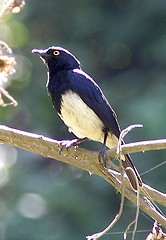Abbott's starling
| Abbott's starling | |
|---|---|

| |
| Male | |

| |
| Female | |
| Scientific classification | |
| Kingdom: | Animalia |
| Phylum: | Chordata |
| Class: | Aves |
| Order: | Passeriformes |
| Family: | Sturnidae |
| Genus: | Poeoptera |
| Species: | P. femoralis
|
| Binomial name | |
| Poeoptera femoralis (Richmond, 1897)
| |
| Synonyms | |
|
Pholia femoralis | |
Abbott's starling (Poeoptera femoralis) is a species of starling in the family Sturnidae. It is found in Kenya and Tanzania. Its natural habitat is subtropical or tropical moist montane forests. It is threatened by habitat loss, and its population is estimated at 2500–9999.[2] This species, at 16 to 18 cm (6.3 to 7.1 in) long, is the smallest species of starling.[3]
The name of the species commemorates William Louis Abbott (1860-1936), American naturalist and collector, who studied the wildlife of the Indo-Malayan region.
Diet[]
The Abbott's starling feeds on insects and fruit, including the fruit of .[4]
Description[]
The Abbott's starling has a black head and breast with white underparts and a yellow eye. Its voice is a musical whistled call moving up and down the scale.[5]
References[]
- ^ BirdLife International (2016). "Poeoptera femoralis". IUCN Red List of Threatened Species. 2016: e.T22710787A94260560. doi:10.2305/IUCN.UK.2016-3.RLTS.T22710787A94260560.en. Retrieved 6 September 2021.
- ^ "Abbott's Starling (Poeoptera femoralis) - BirdLife species factsheet". datazone.birdlife.org. Retrieved 2018-02-21.
- ^ Starlings & Mynas (Helm Identification Guide) by Chris Feare. A&C Black (1998). ISBN 978-0713639612.
- ^ "Abbott's Starling (Poeoptera femoralis)". www.hbw.com. Retrieved 2018-02-21.
- ^ BirdLife International (2016). "Poeoptera femoralis". IUCN Red List of Threatened Species. 2016: e.T22710787A94260560. doi:10.2305/IUCN.UK.2016-3.RLTS.T22710787A94260560.en. Retrieved 6 September 2021.
- IUCN Red List vulnerable species
- Poeoptera
- Birds of East Africa
- Birds described in 1897
- Taxa named by Charles Wallace Richmond
- Sturnidae stubs
